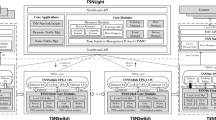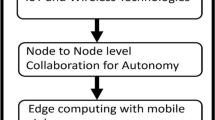Abstract
The most commonly used mechanism for establishing a connection between two communicating entities is transmission control protocol (TCP) that provides a reliable connection. Due to the latest developments in communication technologies, one can use multiple connections in a network using Wi-Fi, LTE/HSPA, etc. Since the single path TCP (SPTCP) provides a single connection at a time, it cannot take the benefit of multiple connections. The multipath TCP (MPTCP) can this problem by dividing a flow into multiple subflows; each may use a different network connection. Thus, it has a great capability to achieve high throughput in comparison to the SPTCP. The existing MPTCP congestion control algorithms have different issues like TCP-friendliness, responsiveness, and load balancing. To address these issues, this paper proposes a new MPTCP congestion control algorithm, named as optimal load balancing linked increased algorithm (OLBLIA), that considers the congestion window corresponding to a path that is least congested. The window corresponding to the least congested path is increased with maximum size (i.e., nearly equal to the congestion window of SPTCP in the best path) that makes it more responsive and friendlier towards the SPTCP. Experimentally and analytically it is shown that the proposed OLBLIA resolves the above mentioned issues and outperforms the existing MPTCP’s congestion control algorithms.





Similar content being viewed by others
References
Robinson, Y. H., & Julie, E. G. (2019). SMR: A synchronized multipath re-broadcasting mechanism for improving the quality of conversational video service. Wireless Personal Communications,104(3), 1149–1173.
Laghari, A. A., He, H., Shafiq, M., & Khan, A. (2018). Application of quality of experience in networked services: Review, trend & perspectives. Systemic Practice and Action Research. https://doi.org/10.4108/eai.13-7-2018.160390.
Chaturvedi, R. K., & Chand, S. (2018). MPTCP over datacenter networks. In 2018 second international conference on inventive communication and computational technologies (ICICCT) (pp. 894–898).
Ford, A., Raiciu, C., Handley, M., & Bonaventure, O. (2012). TCP extensions for multipath operation with multiple addresses, draft-ietf-mptcp-multiaddressed-09. Internetdraft, IETF (March 2012).
Scharf, M., & Ford, A. (2013). Multipath TCP (MPTCP) application interface considerations. RFC 6897, March.
Liu, Y., Neri, A., Ruggeri, A., & Vegni, A. M. (2016). A MPTCP-based network architecture for intelligent train control and traffic management operations. IEEE Transactions on Intelligent Transportation Systems,18(9), 2290–2302.
Syariati, F. M., & Choi, K. W. (2019). Optimal concurrent multipath data transfer for bandwidth aggregation in heterogeneous mobile networks. Wireless Personal Communications,107, 1383–1400.
De Schepper, T., Latré, S., & Famaey, J. (2019). Scalable load balancing and flow management in dynamic heterogeneous wireless networks. Journal of Network and Systems Management. https://doi.org/10.1007/s10922-019-09502-2.
Chow, A. L., Yang, H., Xia, C. H., Kim, M., Liu, Z., & Lei, H. (2009). EMS: Encoded multipath streaming for real-time live streaming applications. In 2009 17th IEEE international conference on network protocols (pp. 233–243).
Lu, Y. (2016). SED: An SDN-based explicit-deadline-aware TCP for cloud data center networks. Tsinghua Science and Technology,21(5), 491–499.
Pang, J., Xu, G., & Fu, X. (2017). SDN-based data center networking with collaboration of multipath TCP and segment routing. IEEE Access,5, 9764–9773.
Raiciu, C., Barre, S., Pluntke, C., Greenhalgh, A., Wischik, D., & Handley, M. (2011). Improving datacenter performance and robustness with multipath TCP. In ACM SIGCOMM computer communication review (Vol. 41, No. 4, pp. 266–277).
Ha, S., Rhee, I., & Xu, L. (2008). CUBIC: A new TCP-friendly high-speed TCP variant. ACM SIGOPS Operating Systems Review,42(5), 64–74.
Sastry, N. R., & Lam, S. S. (2005). CYRF: A theory of window-based unicast congestion control. IEEE/ACM Transactions on Networking (TON),13(2), 330–342.
Ford, A., Raiciu, C., Handley, M., Barre, S., & Iyengar, J. (2011). Architectural guidelines for multipath TCP development. In IETF, RFC 6182.
Hurtig, P., Grinnemo, K. J., Brunstrom, A., Ferlin, S., Alay, Ö., & Kuhn, N. (2018). Low-latency scheduling in MPTCP. IEEE/ACM Transactions on Networking,27(1), 302–315.
Blanton, E., & Allman, M. (2009). TCP congestion control. IETF, Standards Track RFC 5681.
Raiciu, C., Handley, M., & Wischik, D. (2011). RFC 6356, coupled congestion control for multipath transport protocols.
Paasch, C., Khalili, R., & Bonaventure, O. (2013). On the benefits of applying experimental design to improve multipath TCP. In Proceedings of the ninth ACM conference on emerging networking experiments and technologies (pp. 393–398).
Khalili, R., Gast, N., Popovic, M., & Le Boudec, J. Y. (2012). Performance issues with MPTCP. draft-khalili-mptcpperformance-issues-04.
Walid, A., Peng, Q., Hwang, J., & Low, S. (2016). Balanced linked adaptation congestion control algorithm for MPTCP. Working Draft, IETF Secretariat, Internet-Draft draft-walid-mptcp-congestion-control-04.
Khalili, R., Gast, N., & Popovic, M. (2013). Opportunistic linked-increases congestion control algorithm for MPTCP. draft-khalili-mptcp-congestion-control-02.
Kelly, F., & Voice, T. (2005). Stability of end-to-end algorithms for joint routing and rate control. ACM SIGCOMM Computer Communication Review,35(2), 5–12.
Khalili, R., Gast, N., Popovic, M., & Le Boudec, J. Y. (2013). MPTCP is not pareto-optimal: Performance issues and a possible solution. IEEE/ACM Transactions on Networking (ToN),21(5), 1651–1665.
Low, S. H. (2003). A duality model of TCP and queue management algorithms. IEEE/ACM Transactions on Networking (ToN),11(4), 525–536.
Bertsekas, D. P. (1997). Nonlinear programming. Journal of the Operational Research Society,48(3), 332–334.
Vo, P. L., Le, T. A., & Tran, N. H. (2019). mFAST: A multipath congestion control protocol for high bandwidth-delay connection. Mobile Networks and Applications,24(1), 115–123.
Lee, J., Im, Y., & Lee, J. (2019). Modeling MPTCP performance. IEEE Communications Letters,23(4), 616–619.
Network Simulator (NS-3). http://www.nsnam.org. Accessed 2009.
Acknowledgements
This work is supported by UPE-II, Jawaharlal Nehru University, Delhi. Authors like to acknowledge the Council of Scientific & Industrial Research (CSIR) for providing the Fellowship throughout this research.
Author information
Authors and Affiliations
Corresponding author
Additional information
Publisher's Note
Springer Nature remains neutral with regard to jurisdictional claims in published maps and institutional affiliations.
Rights and permissions
About this article
Cite this article
Chaturvedi, R.K., Chand, S. Optimal Load Balancing Linked Increased Algorithm for Multipath TCP. Wireless Pers Commun 111, 1505–1524 (2020). https://doi.org/10.1007/s11277-019-06934-6
Published:
Issue Date:
DOI: https://doi.org/10.1007/s11277-019-06934-6




